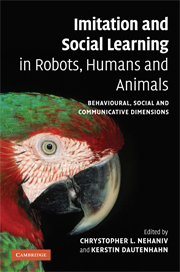 Imitation and Social Learning in Robots, Humans and Animals
Imitation and Social Learning in Robots, Humans and Animals Book contents
- Frontmatter
- Contents
- List of plates
- List of figures
- List of tables
- List of contributors
- Introduction: the constructive interdisciplinary viewpoint for understanding mechanisms and models of imitation and social learning
- Part I Correspondence problems and mechanisms
- Part II Mirroring and ‘mind-reading’
- Part III What to imitate?
- 7 The question of ‘what to imitate’: inferring goals and intentions from demonstrations
- 8 Learning of gestures by imitation in a humanoid robot
- 9 The dynamic emergence of categories through imitation
- Part IV Development and embodiment
- Part V Synchrony and turn-taking as communicative mechanisms
- Part VI Why imitate? – Motivations
- Part VII Social feedback
- Part VIII The ecological context
- Index
- Plate section
- References
8 - Learning of gestures by imitation in a humanoid robot
Published online by Cambridge University Press: 10 December 2009
- Frontmatter
- Contents
- List of plates
- List of figures
- List of tables
- List of contributors
- Introduction: the constructive interdisciplinary viewpoint for understanding mechanisms and models of imitation and social learning
- Part I Correspondence problems and mechanisms
- Part II Mirroring and ‘mind-reading’
- Part III What to imitate?
- 7 The question of ‘what to imitate’: inferring goals and intentions from demonstrations
- 8 Learning of gestures by imitation in a humanoid robot
- 9 The dynamic emergence of categories through imitation
- Part IV Development and embodiment
- Part V Synchrony and turn-taking as communicative mechanisms
- Part VI Why imitate? – Motivations
- Part VII Social feedback
- Part VIII The ecological context
- Index
- Plate section
- References
Summary
Introduction
Traditionally, robotics developed highly specific controllers for the robot to perform a specific set of tasks in highly constrained and deterministic environments. This required the embedding of the controller with an extensive knowledge of the robot's architecture and of its environment. It was soon clear that such an approach would not scale up for controlling robots with multiple degrees of freedom, working in highly variable environments, such as humanoid robots required to interact with humans in their daily environment. The field has now moved to developing more flexible and adaptive control systems, so that the robot would no longer be dedicated to a single task, and could be re-programmed in a fast and efficient manner, to match the end-user needs.
Robot learning by imitation, also referred to as robot programming by demonstration, explores novel means of implicitly teaching a robot new motor skills (Billard and Siegwart, 2004; Dillmann, 2004; Schaal et al., 2003). This field of research takes inspiration in a large and interdisciplinary body of literature on imitation learning, drawing from studies in psychology, ethology and the neurosciences (Demiris and Hayes, 2001; Billard and Hayes, 1999; Alissandrakis et al., 2002). To provide a robot with the ability to imitate is advantageous for at least two reasons: it provides a natural, user-friendly means of implicitly programming the robot; it constrains the search space of motor learning by showing possible and/or optimal solutions.
In this chapter, we explore the issue of recognizing, generalizing and reproducing arbitrary gesture (Billard et al., 2004).
- Type
- Chapter
- Information
- Imitation and Social Learning in Robots, Humans and AnimalsBehavioural, Social and Communicative Dimensions, pp. 153 - 178Publisher: Cambridge University PressPrint publication year: 2007
References
- 47
- Cited by
